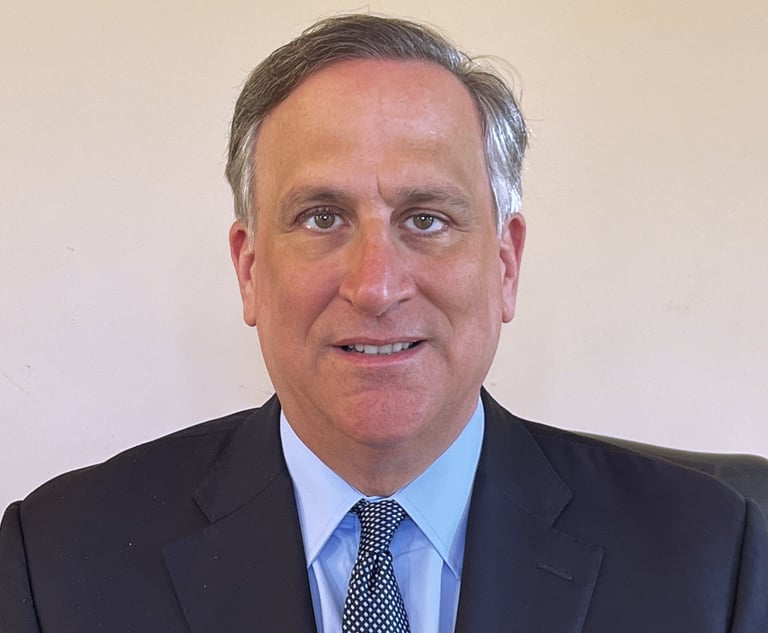Judging the Judges: Bring Back Independent Judicial Evaluations
We recommend that a more comprehensive judicial evaluation process be resurrected and implemented by the CBA.
October 09, 2019 at 12:40 PM
5 minute read
 The current system for evaluating judges is wanting. It is done by the judicial branch itself which sends out a survey after a trial or hearing lasting a certain length to the lawyers involved in these trials or hearings.
The current system for evaluating judges is wanting. It is done by the judicial branch itself which sends out a survey after a trial or hearing lasting a certain length to the lawyers involved in these trials or hearings.
The problem is there are few trials or lengthy hearings these days. That makes the use of those surveys problematic because, although the surveys are submitted anonymously, judges can figure out who the attorneys are who are evaluating them. We commend the committee that designed the current survey, which is well thought out and comprehensive. The problem is the results are kept secret. Few seasoned litigators know how to access the evaluations or the summary of such evaluations or whether such information is in fact accessible at all. If you go to the Connecticut Judicial Website, this information is nowhere to be found.
In 1976, the Connecticut Bar Association developed and implemented a process for evaluating Connecticut state court judges. It covered 12 critical areas under general topics of judicial temperament, legal ability and retention. The CBA weighted the responses of the raters on the basis of their level of experience with a judge, and the raters rated judges anonymously. It shed light on the merits and demerits of sitting judges, with results published in the Connecticut Bar Journal for all to see.
The first year the results were published in 1976, they were accompanied by a thoughtful article by the late Peter L. Costas, who observed that the evaluation "represents a most significant step forward in the quest for improvement of our judicial system." He further remarked that it "is part of a long range program for improving the judicial selection and reappointment process and providing a basis for identifying shortcomings of judges and enabling improvement of their performance." Finally, he addressed a concern that the raters who are lawyers would rate poorly judges who rendered a bad decision or a ruling in cases involving that rater. Attorney Costas found no evidence of such behavior.
The 1976 evaluation process was the product of much hard work that began with the CBA's first survey in 1948. Many improvements were made to the original survey, and the 1976 survey took into account input from the judicial branch. The survey was also evaluated by the American Judicature Society, the gold standard for such evaluations, which observed that it was one of the best in the nation on comprehensiveness, explaining that "[i]t covers the panoply of areas generally considered when the performance of judges is being assessed."
This well-regarded evaluation process was discontinued soon after it was launched. Why? It was primarily due to bruised egos. A few judges received poor evaluations. In 1978, there was a newly appointed chief justice of the Connecticut Supreme Court. The judges who had received these poor evaluations lobbied the chief justice and chief court administrator, who then took their case to the CBA, which was already complaining that it did not have the administrative resources to handle the evaluations. So, in a contentious meeting of the House of Delegates, the votes were cast to kill the evaluations shortly after they were initiated.
In 2016, William Clendenen, then president of the CBA, and other concerned attorneys developed a similar evaluation to the 1976 judicial selection evaluation and presented it to Judge Patrick Carroll, the chief court administrator. Judge Carroll was vehemently opposed to using such a proposed evaluation. The CBA, through the current president, Ndidi N. Moses, is again revisiting the issue of evaluating judges. She and others met with Judge Carroll on Sept. 30 to discuss judicial evaluations being conducted by the CBA.
We recommend a more comprehensive judicial evaluation process be resurrected and implemented by the CBA to shed light on judges' performance, as it did in 1976. Judges are public servants who are not subject to accountability by the electorate. Although their independence is to be safeguarded, and even cherished, especially in this divisive political atmosphere, judges should have some accountability, particularly to the lawyers who practice before them and their clients. The CBA's concerns about administrative burdens will be greatly allayed by the fact that with the internet and survey programs, the administration of such evaluations can largely be automated.
Moreover, the CBA is required by law to provide an evaluation to the Judicial Selection Commission of any state court judge nominee or re-nominee. It presently only provides evaluations of federal court judges. The CBA should start complying with the law and provide the Judicial Selection Commission with the kind of evaluation that it had begun using in 1976. Were this to be resurrected and implemented, it might eliminate some of the rabid and baseless rantings about some judicial re-nominees by some members of the General Assembly's Judiciary Committee that have been harmful to the reputation of these nominees or re-nominees. In this way, these evaluations can serve as both a sword and a shield.
This content has been archived. It is available through our partners, LexisNexis® and Bloomberg Law.
To view this content, please continue to their sites.
Not a Lexis Subscriber?
Subscribe Now
Not a Bloomberg Law Subscriber?
Subscribe Now
NOT FOR REPRINT
© 2025 ALM Global, LLC, All Rights Reserved. Request academic re-use from www.copyright.com. All other uses, submit a request to [email protected]. For more information visit Asset & Logo Licensing.
You Might Like
View All
ADVANCE Act Offers Conn. Opportunity to Enhance Carbon-Free Energy and Improve Reliability With Advanced Nuclear Technologies

Trending Stories
- 1Trump's DOJ Delays Releasing Jan. 6 FBI Agents List Under Consent Order
- 2Securities Report Says That 2024 Settlements Passed a Total of $5.2B
- 3'Intrusive' Parental Supervision Orders Are Illegal, NY Appeals Court Says
- 4Federal Laws Also Preempt State's Swipe Fee Law on Out-of-State Banks, Judge Rules
- 5Judge Grills DOJ on Trump’s Birthright Citizenship Executive Order
Who Got The Work
J. Brugh Lower of Gibbons has entered an appearance for industrial equipment supplier Devco Corporation in a pending trademark infringement lawsuit. The suit, accusing the defendant of selling knock-off Graco products, was filed Dec. 18 in New Jersey District Court by Rivkin Radler on behalf of Graco Inc. and Graco Minnesota. The case, assigned to U.S. District Judge Zahid N. Quraishi, is 3:24-cv-11294, Graco Inc. et al v. Devco Corporation.
Who Got The Work
Rebecca Maller-Stein and Kent A. Yalowitz of Arnold & Porter Kaye Scholer have entered their appearances for Hanaco Venture Capital and its executives, Lior Prosor and David Frankel, in a pending securities lawsuit. The action, filed on Dec. 24 in New York Southern District Court by Zell, Aron & Co. on behalf of Goldeneye Advisors, accuses the defendants of negligently and fraudulently managing the plaintiff's $1 million investment. The case, assigned to U.S. District Judge Vernon S. Broderick, is 1:24-cv-09918, Goldeneye Advisors, LLC v. Hanaco Venture Capital, Ltd. et al.
Who Got The Work
Attorneys from A&O Shearman has stepped in as defense counsel for Toronto-Dominion Bank and other defendants in a pending securities class action. The suit, filed Dec. 11 in New York Southern District Court by Bleichmar Fonti & Auld, accuses the defendants of concealing the bank's 'pervasive' deficiencies in regards to its compliance with the Bank Secrecy Act and the quality of its anti-money laundering controls. The case, assigned to U.S. District Judge Arun Subramanian, is 1:24-cv-09445, Gonzalez v. The Toronto-Dominion Bank et al.
Who Got The Work
Crown Castle International, a Pennsylvania company providing shared communications infrastructure, has turned to Luke D. Wolf of Gordon Rees Scully Mansukhani to fend off a pending breach-of-contract lawsuit. The court action, filed Nov. 25 in Michigan Eastern District Court by Hooper Hathaway PC on behalf of The Town Residences LLC, accuses Crown Castle of failing to transfer approximately $30,000 in utility payments from T-Mobile in breach of a roof-top lease and assignment agreement. The case, assigned to U.S. District Judge Susan K. Declercq, is 2:24-cv-13131, The Town Residences LLC v. T-Mobile US, Inc. et al.
Who Got The Work
Wilfred P. Coronato and Daniel M. Schwartz of McCarter & English have stepped in as defense counsel to Electrolux Home Products Inc. in a pending product liability lawsuit. The court action, filed Nov. 26 in New York Eastern District Court by Poulos Lopiccolo PC and Nagel Rice LLP on behalf of David Stern, alleges that the defendant's refrigerators’ drawers and shelving repeatedly break and fall apart within months after purchase. The case, assigned to U.S. District Judge Joan M. Azrack, is 2:24-cv-08204, Stern v. Electrolux Home Products, Inc.
Featured Firms
Law Offices of Gary Martin Hays & Associates, P.C.
(470) 294-1674
Law Offices of Mark E. Salomone
(857) 444-6468
Smith & Hassler
(713) 739-1250












